Ukraine crisis: Timeline
- Published
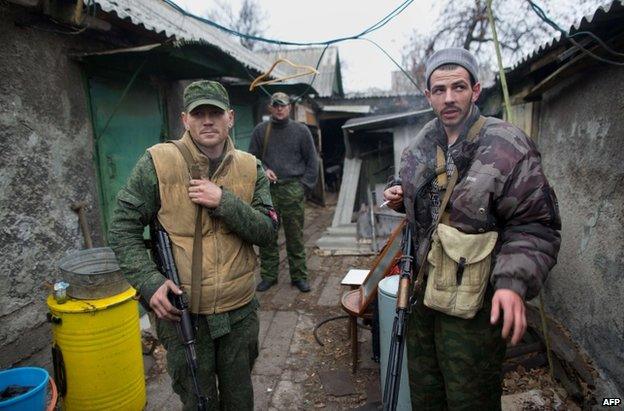
Pro-Russian gunmen in Donetsk, 13 November
For months, pro-Russian separatists have fought Ukrainian forces in two eastern regions of Ukraine but a fragile ceasefire has been agreed by both sides.
Here is a timeline of events in the most dangerous conflict to grip Europe since the wars in the former Yugoslavia.

November 2014
12 November: Nato commander Gen Philip Breedlove says Russian military equipment and Russian combat troops have been seen entering Ukraine in columns over several days.
11 November: Dutch efforts to salvage wreckage from the Malaysia Airlines crash site stall over disagreements with local rebel groups.
MH17 Dutch memorial day: Air disaster that touched a nation
2-3 November: Separatists in eastern Ukraine elect new leaders in polls backed by Russia and denounced by the West. President Poroshenko accuses the rebels of jeopardising "the entire peace process" and says Ukrainian forces should prepare defences against separatist attack.

October 2014
31 October: Russia agrees to resume gas supplies to Ukraine over the winter in a deal brokered by the EU.
Russia's gas fight with Ukraine
26 October: Pro-Western parties win Ukraine's parliamentary elections.
Ukraine ready to trash politicians
21 October: Human Rights Watch says it has strong evidence Ukraine attacked populated areas of Donetsk with cluster bombs, banned by many other states.
12 October: President Putin orders thousands of troops stationed near the Ukrainian border to return to their bases.

September 2014
Watch: Timeline summary of the Ukraine conflict
24 September: Nato reports a "significant" withdrawal of Russian troops from eastern Ukraine.
9 September: Dutch experts find that Malaysia Airlines flight MH17 broke up in mid-air after being hit by "objects" that "pierced the plane at high velocity" in July.
5 September: Ukraine and pro-Russian rebels sign a truce in Minsk.
1 September: Ukraine says 700 of its men have been taken prisoner as pro-Russian rebels advance in the east.

August 2014
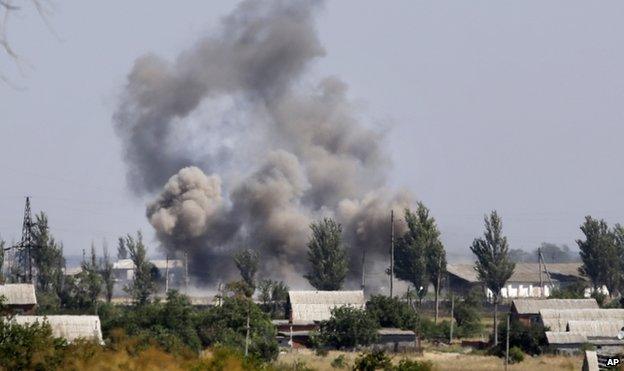
Rebels seized Novoazovsk and surrounding villages, and threatened to attack the port city of Mariupol
27-28 August: Rebel leader Alexander Zakharchenko says there are 3-4,000 Russian civilians in rebel ranks as the separatists open up a front on the Sea of Azov and capture Novoazovsk.
26 August: Ukraine releases videos of captured Russian paratroopers. They are later exchanged for Ukrainian soldiers.
22 August: A huge Russian convoy delivers humanitarian aid to the government-besieged city of Luhansk without Ukrainian permission.

July 2014
30 July: The EU and US announce new sanctions against Russia.

The downing of MH17 caused outrage in the countries affected by the disaster, particularly the Netherlands
17 July: Malaysia Airlines flight MH17 from Amsterdam is shot down near the village of Grabove in rebel-held territory, with the loss of 298 lives.

The Ukrainian army's capture of Sloviansk was seen as the "start of a turning point" by President Poroshenko
5 July: Rebels abandon their command centre at Sloviansk in the face of a government offensive.

June 2014
27 June: The EU signs a landmark association agreement with Ukraine.
25 June: Russia's parliament cancels a parliamentary resolution authorising the use of Russian forces in Ukraine.
Daniel Sandford visited Luhansk and witnessed to toll the conflict has inflicted
14 June: Pro-Russia separatists shoot down a military plane in the east, killing 49 people.
The meeting came as fighting continued in eastern Ukraine
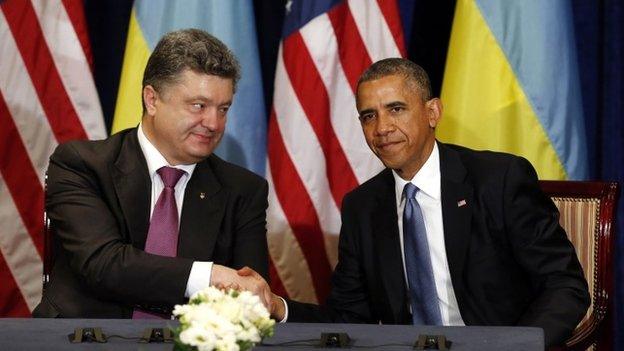
Mr Obama described Mr Poroshenko in early June as a "wise selection" for leader of Ukraine

May 2014
Amateur footage posted online appears to show the aftermath of the helicopter being downed, as the BBC's Mark Lowen reports
25 May: Ukraine elects Petro Poroshenko as president in an election not held in much of the east.
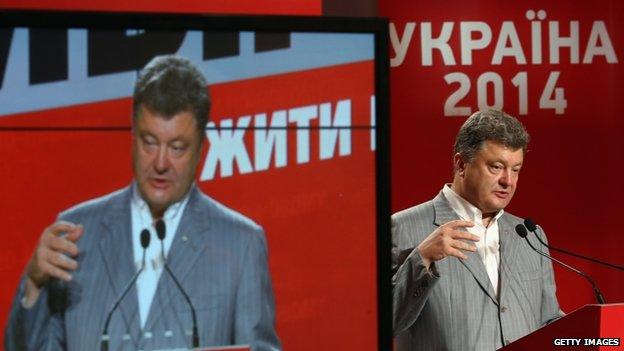
Petro Poroshenko won 54.7% of the vote, enough to avoid a second round
11 May: Pro-Russian separatists in Donetsk and Luhansk declare independence after unrecognised referendums.
2 May: Clashes in the Black Sea city of Odessa, leave 42 people dead, most of them pro-Russian activists. Most die when they are trapped in a burning building.

Nearly 40 people died inside the trade union building when a fire broke out during protests

April 2014
22 April: Ukraine's acting president orders the relaunch of military operations against pro-Russian militants in the east.
Politician Vladimir Rybak disappeared after being filmed trying to gain access to a building seized by pro-Russian activists, as Daniel Sandford reports from Donetsk
17 April: Russia, Ukraine, the US and the EU say they have agreed at talks in Geneva on steps to "de-escalate" the crisis in eastern Ukraine. Three people are killed when Ukrainian security forces fend off a raid on a base in Mariupol - the first violent deaths in the east.
Footage posted on YouTube appears to show the moment a police station in Sloviansk was seized
15 April: Ukraine's acting President, Olexander Turchynov, announces the start of an "anti-terrorist operation" against pro-Russian separatists. It quickly stalls.
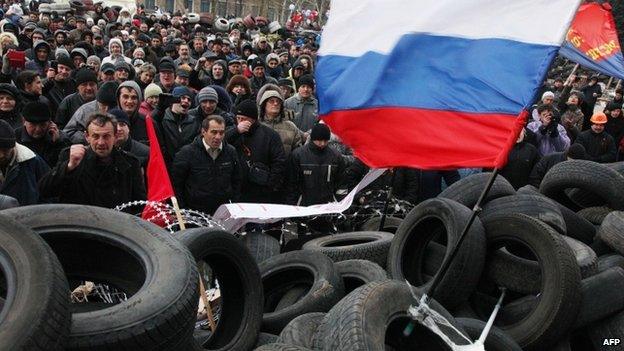
Pro-Russia activists barricaded the regional state administration in the eastern city of Donetsk
7 April: Protesters occupy government buildings in the east Ukrainian cities of Donetsk, Luhansk and Kharkiv, calling for a referendum on independence. Ukrainian authorities regain control of Kharkiv government buildings the next day.

March 2014
28 March: US President Barack Obama urges Moscow to "move back its troops" and lower tensions.
18 March: President Putin signs a bill to absorb Crimea into the Russian Federation.
17 March: The EU and US impose travel bans and asset freezes on several officials from Russia and Ukraine over the Crimea referendum.
16 March: Crimea's secession referendum on joining Russia is backed by 97% of voters, organisers say, but vote condemned by West as a sham.
Fear and unease in Novo-Ozyorne
1 March: Russia's parliament approves President Vladimir Putin's request to use force in Ukraine to protect Russian interests.
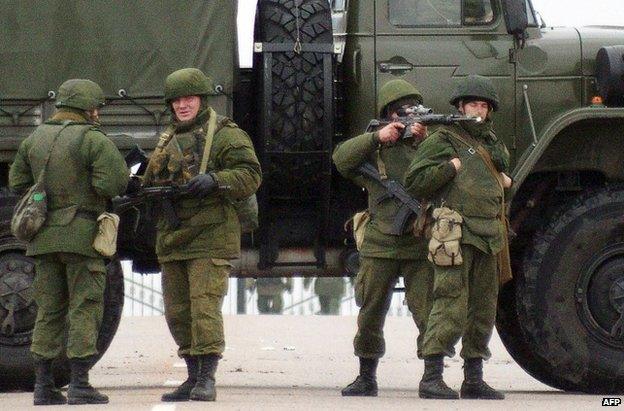
Unidentified gunmen near Sevastopol's airport in Crimea on 28 February

February 2014
27-28 February: Pro-Russian gunmen seize key buildings in the Crimean capital, Simferopol. Unidentified gunmen in combat uniforms appear outside Crimea's main airports.
The BBC's Mark Lowen reports on the armed stand-off in Simferopol
23-26 February:
Parliament votes to ban Russian as the second official language, causing a wave of anger in Russian-speaking regions; the vote is later overturned
Parliament names speaker Olexander Turchynov as interim president
An arrest warrant is issued for Mr Yanukovych
Arseniy Yatsenyuk is nominated prime minister.
The elite Berkut police unit, blamed for deaths of protesters, is disbanded
The BBC's Gavin Hewitt reports on the presentation of the interim government
22 February:
President Yanukovych disappears
Protesters take control of presidential administration buildings
Parliament votes to remove president from power with elections set for 25 May
Mr Yanukovych appears on TV to denounce "coup"
His arch-rival Yulia Tymoshenko is freed from jail
Former PM Yulia Tymoshenko made an emotional speech to protesters at Kiev's Independence Square, as Gavin Hewitt reports
21 February: President Yanukovych signs compromise deal with opposition leaders.

President Yanukovych (C) signed a 21 February deal with opposition leaders that soon became redundant
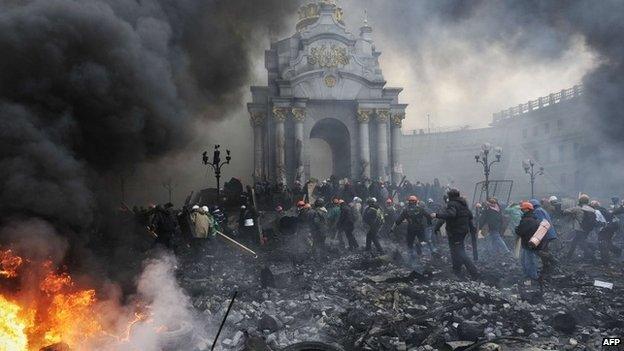
Independence Square resembled a battlefield after the 20 February clashes
20 February: Kiev sees its worst day of violence for almost 70 years. At least 88 people are killed in 48 hours. Video shows uniformed snipers firing at protesters holding makeshift shields.
Newsnight releases un-broadcast footage of the clashes in Kiev in which many died
Images of Independence Square, before and after the clashes
18 February: Clashes erupt, with reasons unclear: 18 dead.
The BBC's Daniel Sandford witnesses Ukraine's "descent into insanity"
14-16 February: All 234 protesters arrested since December are released. Kiev city hall, occupied since 1 December, is abandoned by demonstrators, along with other public buildings in regions.

January 2014
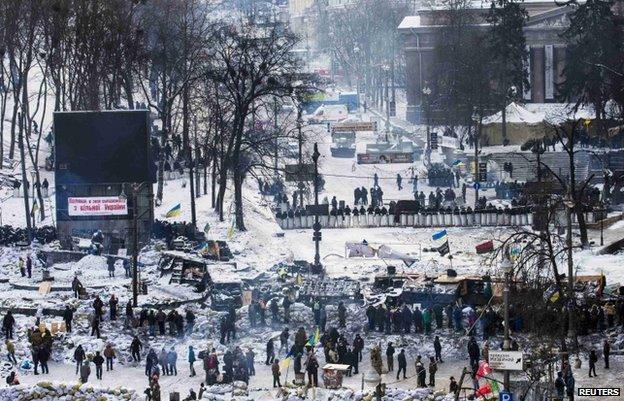
Riot police and protesters face off in Independence Square
28-29 January: Prime Minister Mykola Azarov resigns and parliament annuls the anti-protest law. Parliament passes amnesty bill but opposition rejects conditions.
The BBC's Daniel Sandford: "This central Kiev square is like a vision of hell"
16-23 January: Parliament passes restrictive anti-protest laws as clashes turn deadly. Protesters begin storming regional government offices in western Ukraine.

December 2013
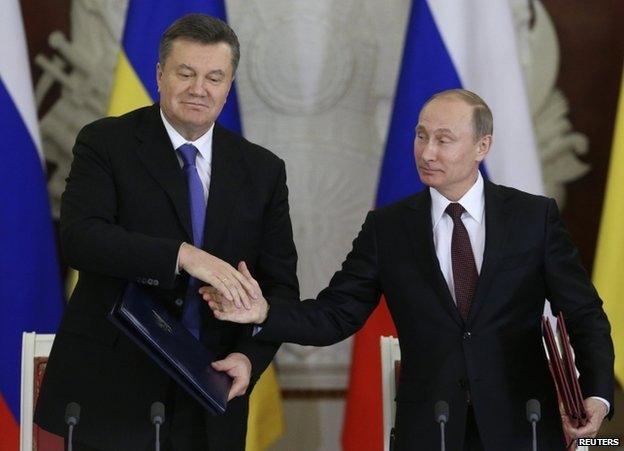
President Viktor Yanukovych signed $15bn Russian deal with President Putin in Moscow
17 December: Vladimir Putin throws President Yanukovych an economic lifeline, agreeing to buy $15bn of Ukrainian debt and reduce the price of Russian gas supplies by about a third.
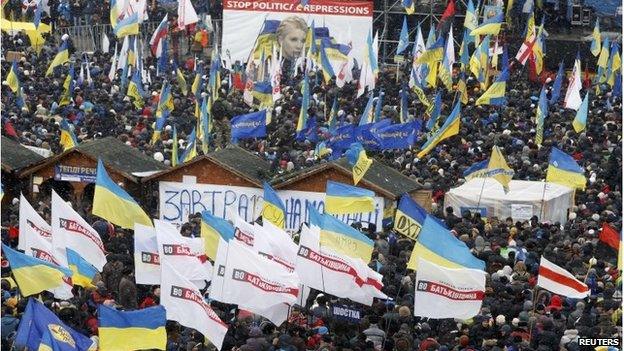
The biggest protest so far took place in Kiev on 8 December
Early December: Protesters occupy Kiev city hall and Independence Square in dramatic style. Some 800,000 people rally in Kiev.
The BBC's Steve Rosenberg says the clashes were on the fringe of an otherwise fairly peaceful protest

November 2013
Late November: Protests gather pace, as 100,000 people attend a demonstration in Kiev.
The BBC's David Stern says protests are continuing in Ukraine
21 November: President Yanukovych's cabinet abandons an agreement on closer trade ties with EU, instead seeking closer co-operation with Russia. Small protests start.

2010
February: Viktor Yanukovych is declared the winner in a presidential election judged free and fair by observers. His main rival, Prime Minister Yulia Tymoshenko, is arrested for abuse of powers and eventually jailed in October 2011.

2004
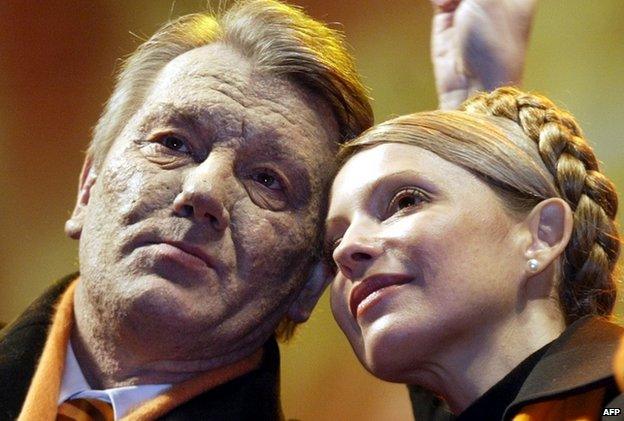
Opposition leaders Viktor Yushchenko and Yulia Tymoshenko led the 2004 mass protests
December: Opposition candidate Viktor Yushchenko tops poll in election re-run. Rival candidate Viktor Yanukovych challenges result but resigns as prime minister.
November: Orange Revolution begins after reports of widespread vote-rigging in presidential election nominally won by pro-Russian candidate Viktor Yanukovych. Opposition candidate Viktor Yushchenko leads mass street protests and civil disobedience. Supreme Court annuls result of poll.

1991
August: Ukrainian parliament declares independence from USSR following attempted coup in Moscow. In a nationwide referendum in December, 90% vote for independence.